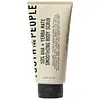Youth To The People 10% AHA + Yerba Mate Smoothing Energy Body Scrub Versus Necessaire The Body Wash
What's inside
What's inside
 Key Ingredients
Key Ingredients

 Benefits
Benefits

 Concerns
Concerns

 Ingredients Side-by-side
Ingredients Side-by-side

Water
Skin ConditioningPerlite
AbsorbentLactic Acid
BufferingGlycerin
HumectantSodium Hydroxide
BufferingSodium Cocoyl Isethionate
CleansingStearyl Alcohol
EmollientSimmondsia Chinensis Seed Oil
EmollientPropanediol
SolventGlyceryl Stearate
EmollientMandelic Acid
AntimicrobialCeteareth-20
CleansingGlycolic Acid
BufferingOlea Europaea Seed Powder
AbrasiveGluconolactone
Skin ConditioningTridecyl Trimellitate
EmollientHylocereus Undatus Fruit Extract
Skin ConditioningIlex Guayusa Leaf Extract
Skin ProtectingIlex Paraguariensis Leaf Extract
PerfumingPassiflora Edulis Fruit Extract
Skin ConditioningBisabolol
MaskingCaffeine
Skin ConditioningTrisodium Ethylenediamine Disuccinate
Hydrogenated Castor Oil
EmollientHydrogenated Jojoba Oil
AbrasiveCaprylyl Glycol
EmollientCitric Acid
BufferingCoconut Acid
CleansingIsohexadecane
EmollientPolysorbate 80
EmulsifyingSodium Acrylate/Sodium Acryloyldimethyl Taurate Copolymer
Emulsion StabilisingSodium Isethionate
CleansingSorbitan Oleate
EmulsifyingXanthan Gum
EmulsifyingLimonene
PerfumingLinalool
PerfumingPhenoxyethanol
PreservativePotassium Sorbate
PreservativeSodium Benzoate
MaskingParfum
MaskingWater, Perlite, Lactic Acid, Glycerin, Sodium Hydroxide, Sodium Cocoyl Isethionate, Stearyl Alcohol, Simmondsia Chinensis Seed Oil, Propanediol, Glyceryl Stearate, Mandelic Acid, Ceteareth-20, Glycolic Acid, Olea Europaea Seed Powder, Gluconolactone, Tridecyl Trimellitate, Hylocereus Undatus Fruit Extract, Ilex Guayusa Leaf Extract, Ilex Paraguariensis Leaf Extract, Passiflora Edulis Fruit Extract, Bisabolol, Caffeine, Trisodium Ethylenediamine Disuccinate, Hydrogenated Castor Oil, Hydrogenated Jojoba Oil, Caprylyl Glycol, Citric Acid, Coconut Acid, Isohexadecane, Polysorbate 80, Sodium Acrylate/Sodium Acryloyldimethyl Taurate Copolymer, Sodium Isethionate, Sorbitan Oleate, Xanthan Gum, Limonene, Linalool, Phenoxyethanol, Potassium Sorbate, Sodium Benzoate, Parfum
Water
Skin ConditioningSodium Laurylglucosides Hydroxypropylsulfonate
CleansingCoco-Glucoside
CleansingDisodium Cocoamphodiacetate
CleansingGlycerin
HumectantSodium Methyl Cocoyl Taurate
CleansingSodium Chloride
MaskingNiacinamide
SmoothingTocopherol
AntioxidantSaccharum Officinarum Extract
MoisturisingPyrus Malus Fruit Extract
Skin ConditioningCitrus Aurantium Dulcis Fruit Extract
MaskingCitrus Limon Fruit Extract
MaskingCamellia Sinensis Leaf Extract
AntimicrobialSclerocarya Birrea Seed Oil
HumectantCaryodendron Orinocense Seed Oil
EmollientLimnanthes Alba Seed Oil
Skin ConditioningCaprylyl Glycol
EmollientPhenoxyethanol
PreservativeCitric Acid
BufferingChlorphenesin
AntimicrobialSodium Phytate
Eucalyptus Globulus Leaf Oil
PerfumingLavandula Angustifolia Oil
MaskingAbies Sibirica Oil
MaskingZingiber Officinale Root Oil
MaskingCitrus Aurantium Dulcis Peel Oil
MaskingPogostemon Cablin Leaf Oil
MaskingWater, Sodium Laurylglucosides Hydroxypropylsulfonate, Coco-Glucoside, Disodium Cocoamphodiacetate, Glycerin, Sodium Methyl Cocoyl Taurate, Sodium Chloride, Niacinamide, Tocopherol, Saccharum Officinarum Extract, Pyrus Malus Fruit Extract, Citrus Aurantium Dulcis Fruit Extract, Citrus Limon Fruit Extract, Camellia Sinensis Leaf Extract, Sclerocarya Birrea Seed Oil, Caryodendron Orinocense Seed Oil, Limnanthes Alba Seed Oil, Caprylyl Glycol, Phenoxyethanol, Citric Acid, Chlorphenesin, Sodium Phytate, Eucalyptus Globulus Leaf Oil, Lavandula Angustifolia Oil, Abies Sibirica Oil, Zingiber Officinale Root Oil, Citrus Aurantium Dulcis Peel Oil, Pogostemon Cablin Leaf Oil
 Reviews
Reviews

Ingredients Explained
These ingredients are found in both products.
Ingredients higher up in an ingredient list are typically present in a larger amount.
Caprylyl Glycol is a humectant and emollient, meaning it attracts and preserves moisture.
It is a common ingredient in many products, especially those designed to hydrate skin. The primary benefits are retaining moisture, skin softening, and promoting a healthy skin barrier.
Though Caprylyl Glycol is an alcohol derived from fatty acids, it is not the kind that can dry out skin.
This ingredient is also used as a preservative to extend the life of products. It has slight antimicrobial properties.
Learn more about Caprylyl GlycolCitric Acid is an alpha hydroxy acid (AHA) naturally found in citrus fruits like oranges, lemons, and limes.
Like other AHAs, citric acid can exfoliate skin by breaking down the bonds that hold dead skin cells together. This helps reveal smoother and brighter skin underneath.
However, this exfoliating effect only happens at high concentrations (20%) which can be hard to find in cosmetic products.
Due to this, citric acid is usually included in small amounts as a pH adjuster. This helps keep products slightly more acidic and compatible with skin's natural pH.
In skincare formulas, citric acid can:
While it can provide some skin benefits, research shows lactic acid and glycolic acid are generally more effective and less irritating exfoliants.
Most citric acid used in skincare today is made by fermenting sugars (usually from molasses). This synthetic version is identical to the natural citrus form but easier to stabilize and use in formulations.
Read more about some other popular AHA's here:
Learn more about Citric AcidGlycerin is already naturally found in your skin. It helps moisturize and protect your skin.
A study from 2016 found glycerin to be more effective as a humectant than AHAs and hyaluronic acid.
As a humectant, it helps the skin stay hydrated by pulling moisture to your skin. The low molecular weight of glycerin allows it to pull moisture into the deeper layers of your skin.
Hydrated skin improves your skin barrier; Your skin barrier helps protect against irritants and bacteria.
Glycerin has also been found to have antimicrobial and antiviral properties. Due to these properties, glycerin is often used in wound and burn treatments.
In cosmetics, glycerin is usually derived from plants such as soybean or palm. However, it can also be sourced from animals, such as tallow or animal fat.
This ingredient is organic, colorless, odorless, and non-toxic.
Glycerin is the name for this ingredient in American English. British English uses Glycerol/Glycerine.
Learn more about GlycerinPhenoxyethanol is a preservative that has germicide, antimicrobial, and aromatic properties. Studies show that phenoxyethanol can prevent microbial growth. By itself, it has a scent that is similar to that of a rose.
It's often used in formulations along with Caprylyl Glycol to preserve the shelf life of products.
Water. It's the most common cosmetic ingredient of all. You'll usually see it at the top of ingredient lists, meaning that it makes up the largest part of the product.
So why is it so popular? Water most often acts as a solvent - this means that it helps dissolve other ingredients into the formulation.
You'll also recognize water as that liquid we all need to stay alive. If you see this, drink a glass of water. Stay hydrated!
Learn more about Water